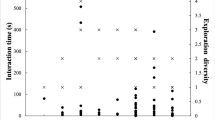Abstract
I studied animal prey foraging by three outdoor groups of Geoffroy’s marmosets, Callithrix geoffroyi, over the course of two summers (June–August 1994; August–September, 1995. Marmosets are highly motivated to forage for animal prey, as demonstrated by the amount of time spent foraging for insects and small vertebrates even in the presence of provisioned, high-quality food. Like their wild congeners, the marmosets engaged in prolonged visual searches of selected areas while slowly locomoting. They seldom used their hands to manipulate substrates. The marmosets were startled proportionately more often while foraging for animal prey than would be predicted by their overall time budgets, and they regularly, if briefly, interrupted their search/locomote pattern with sweeping scans of the surroundings that may contribute to a vigilance function. While carrying infants, they almost never foraged. These results are consistent with the notion that marmosets may be particularly vulnerable to predation while searching for animal prey. Most of the data on marmoset and tamarin feeding ecology have focused on fruits and gums. My data underscore the need to understand better the role of animal prey in the behavioral ecology of callitrichids.
Similar content being viewed by others
References
Caine, N. G. (1993). Flexibility and cooperation as unifying themes inSaguinus social organization and behaviour: The role of predation pressures. In Rylands, A. B. (ed.),Marmosets and Tamarins. Systematics, Behaviour, and Ecology, Oxford University Press, Oxford, pp. 200–219.
Caine, N. G., and Marra, S. L. (1988). Vigilance and social organization in two species of primates.Anim. Behav. 36: 897–904.
Caine, N. G., and O’Boyle, V. J. (1992). Cage design and forms of play in red-bellied tamarins,Saguinus labiatus.Zoo Biol. 11: 215–220.
Caine, N. G., and Weldon, P. J. (1989). Responses by red-bellied tamarins,Saguinus labiatus, to fecal scents of predatory and nonpredatory Neotropical mammals.Biotropica 21: 186–189.
Ferrari, S. F. (1993). Ecological differentiation in the Callitrichidae. In Rylands, A. B. (ed.),Marmosets and Tamarins. Systematics, Behaviour, and Ecology, Oxford University Press, Oxford, pp. 314–328.
Ferrari, S. F., and Lopes Ferrari, M. A. (1990). Predator avoidance behaviour in the buffy-headed marmoset,Callithrix flaviceps.Primates 31: 323–338.
Ferrari, S. F. and Rylands, A. B. (1994). Activity budgets and differential visibility in field studies of three marmosets (Callithrix spp.).Folia Primatol. 63: 78–83.
FitzGibbon, C. D. (1989). A cost to individuals with reduced vigilance in groups of Thomson’s gazelles hunted by cheetahs.Anim. Behav. 37: 508–510.
Garber, P. A. (1993). Feeding ecology and behaviour of the genusSaguinus. In Rylands, A. B. (ed.),Marmosets and Tamarins. Systematics, Behaviour, and Ecology, Oxford University Press, Oxford, pp. 273–295.
Gaston, A. J. (1977). Social behaviour within groups of jungle babblers.Anim. Behav. 25: 828–848.
Heymann, E. W. (1987). A field observation of predation on a moustached tamarin(Saguinus mystax) by an anaconda.Int. J. Primatol. 8: 193–195.
Heymann, E. W. (1990). Reactions of wild tamarins,Saguinus mystax and 5.fuscicollis, to avian predators.Int. J. Primatol. 11: 327–337.
Horrocks, J. A., and Hunte, J. (1986). Sentinel behaviour in vervet monkeys: Who sees whom first?Anim. Behav. 34(5.) 1556–1557.
Isbell, L. A. and Young, T. P. (1993). Social and ecological influences on activity budgets of vervet monkeys, and their implications for group living.Behav. Ecol. Sociobiol, 32, 377–385.
La Tourette, T., and Searcy, Y. M. (1995) Startle responses in captive Geoffroy’s tufted-ear marmosetsCallithrix geoffroyi, Unpublished manuscript.
Lima, S. L. (1995). Back to the basics of antipredatory vigilance: The group-size effect.Anim. Behav. 49: 11–20.
Martin, P. and Bateson, P. (1993).Measuring Behaviour, Cambridge University Press, Cambridge.
Peres, C. A. (1993). Diet and feeding ecology of saddle-back tamarins (Saguinus fuscicollis) and moustached tamarins (5.mystax) in an Amazonianterra firme forest.J. Zool. London. 230: 567–569.
Price, E. C. (1991). The costs and benefits of infant carrying in captive cotton-top tamarins.Am. J. Primatol. 26: 23–33.
Pulliam, H. R. (1973). On the advantages of flocking.J. Theor. Biol. 38: 419–422.
Quenette, P.-Y. (1990). Functions of vigilance in mammals: A review.Acta Oecol., 11: 801–818.
Rylands, A. B. (1989). Sympatric Brazilian callitrichids: The black tufted-ear marmoset,Callithrix kuhli, and the golden-headed lion tamarin,Leontopithecus chrysomelas.J. Hum. Evol. 18: 679–695.
Rylands, A. B. (1993). The ecology of the lion tamarins,Leontopithecus: some intrageneric differences and comparisons with other callitrichids. In Rylands, A. B. (ed.),Marmosets and Tamarins. Systematics, Behaviour, and Ecology, Oxford University Press, Oxford, pp. 296–313.
Rylands, A. B., and Faria, D. S. (1993). Habitats, feeding ecology, and home range size in the genusCallithrix. In Rylands, A. B. (ed.),Marmosets and Tamarins. Systematics, Behaviour, and Ecology, Oxford University Press, Oxford, pp. 262–272.
Stevenson, M. F., and Rylands, A. B. (1988). The marmosets, genusCallithrix. In Mittermeier, R. A., Rylands. A. B., Coimbra-Filho, A. F., and Fonseca, G. A. B. (eds.),Ecology and Behaviour of Neotropical Primates, Vol. 2, World Wildlife Fund, Washington, DC, pp. 131–222.
Tardif, S. (1994). Relative energetic cost of infant care in small bodied Neotropical primates and its relation to infant-care patterns.Am. J. Primatol. 34: 133–143.
Author information
Authors and Affiliations
Rights and permissions
About this article
Cite this article
Caine, N.G. Foraging for animal prey by outdoor groups of Geoffroy’s marmosets (Callithrix geoffroyi). Int J Primatol 17, 933–945 (1996). https://doi.org/10.1007/BF02735295
Received:
Revised:
Accepted:
Issue Date:
DOI: https://doi.org/10.1007/BF02735295




